The Golem
Modding my Rickenbacker 360/12
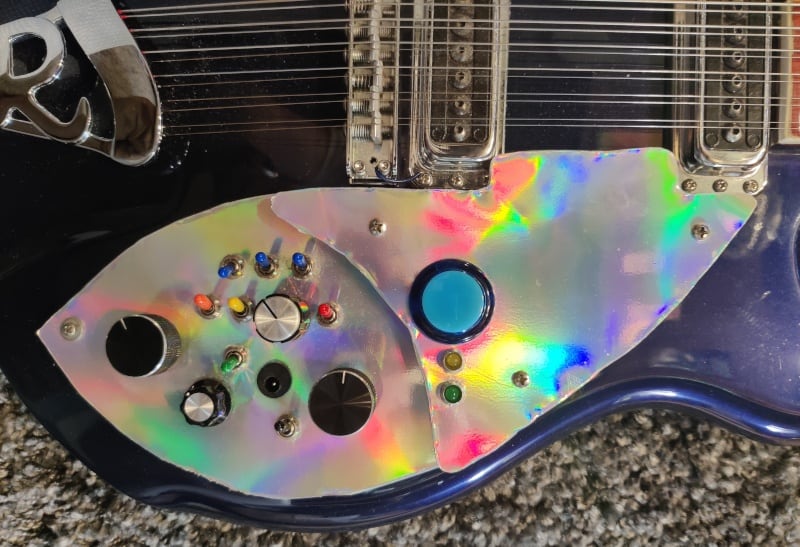
Introduction
About a year ago, over the course of a few weeks, I completely gutted and replaced the electronics in my Ric. While at first sight it might seem sacrilegious to modify a Rickenbacker 360/12 like this—I can assure you I have not lost my mind.
- I set aside the original pickguard with all the electronics.
- I didn't remove any material and the whole thing is reversible with a little solder.
- These are all sensible mods.
- It's my guitar and I can make it awesome if I want to.
What am I Looking At?
Let's answer this question before I get into any stories. Looking at the photo above…
- First row: pickup toggles (blue)
- Piezo
- Bridge
- Neck
- Second row of toggles:
- Toggle (orange) Dan Armstrong Orange Squeezer clone
- Toggle (yellow) Alembic Strat-o-blaster clone with gain knob
- Toggle (red) Vox Treble Booster clone
- Then zig-zagging around the bottom…
- Pre-effects volume knob (black) that is a pull switch that adds a pair of Germanium 1N34A clipping diodes.
- Toggle (green) and rate knob (silver top) for tremolo. The power is separate from the rest of the circuitry to minimize clicking. There is a small sliding toggle hidden between the pickguards.
- 9V power jack
- Toggle (black) that bypasses all the buffers and onboard electronics
- Post-effects volume knob (black) that is a pull switch that bypasses the pedalboard
- Arcade-style kill switch
- The three LEDs (including the kill switch):
- (blue) indicates power
- (yellow) currently also indicates power but I'm planning to make it show how hard the compression is working
- (green) tremolo rate
History
I bought this guitar new in 2010 and it has mostly behaved itself. I wasn't fully utilizing most of the existing controls. I pretty much kept the tone knobs and volume knobs dimed and I only came to understand how the fifth knob works1 after I removed it.
I wanted more convenience and better performance from the pedals I always left on. The compressor on the floor was too noisy. I craved some kind of built-in modulation. I envisioned features that would compliment the beautiful instrument I already had.
So, I set out to find simple circuits that would be small and not consume too much power.
Roger McGuinn
Having the Ric 360/12 meant I was already in Roger McGuinn's shadow, so I researched his gear. I learned he put a Vox Treble Booster into his guitar and later had someone from Rickenbacker add a compressor, though now he recommends using a Janglebox. The compressor schematics were hard to find and people on the forums say the original circuit isn't even that great. So I went with a compressor that I knew would be simple and I wouldn't have to fiddle with any knobs—the Dan Armstrong Orange Squeezer.
So far, I'm being reasonable, right?
Jerry Garcia
I happened upon this video, How to Sound Like Jerry Garcia: DIY Grateful Dead Guitar Rig, and I knew I needed a few more “reasonable” things.
Jerry Garcia's tone is due in large part to the preamp built right into the guitar. He's had several over the years, but I chose to clone the Alembic Strat-o-blaster because I thought the transistors would use less power than an opamp. (Looking back, I'm not convinced that's the case.)
Beyond that he had a volume knob on his guitar that controlled the volume after his effects. They call it an OBEL, or Onboard Effects Loop. The signal is buffered in the guitar for the long trip to the effects and back before going to the amp. This allowed him to adjust his volume without changing how his envelope filter or fuzz responded. He could also flip a switch to bypass his effects altogether. Neat!
I've definitely had gigs before where, mid-song, it's apparent my volume isn't where it should be. Being able to adjust from the guitar instead of fiddling with dirt pedal levels would be incredibly handy.
I really tried to find a way to get a post-effect volume knob without having so many cables going in and out of the guitar. But I realized my Ric already had a mono and stereo jack as part of the Ric-O-Sound2 feature which I never found a worthwhile way to use.
Add a JFET and a preamp, and Bob's your uncle.
That Old Western Sound
Somewhere between psychedelia and surf lies a glorious tremolo sound that adds a beautiful shimmer to an already shimmery twelve-string strum. I loved how my Ric sounded through the tremolo in my Rickenbacker T-25 practice amp, but I couldn't quite figure out how to clone it from the schematic.
I checked out a lot of tremolo circuits. None stood out and I thought, “how hard can it be to make the volume go up and down?” At the time it was pretty hard for me. I tried a few different approaches, gave up, revisited earlier ones, and gave up again.
Eventually, I learned how to make a simple alternating LED-blinking circuit with capacitors and I paired the LEDs with LDRs (Light Dependent Resistors). I also wanted to take advantage of having the circuit inside the guitar, so I came up with a tremolo that alternates volume between the two pickups. It thought it would sound like a harmonic tremolo, but because LDRs have different resistance across frequencies, it actually sounds more like a Uni-Vibe. Cool!
Other Experiments
Over the course of a year, I learned a lot. It was pretty finicky at first. I refined the circuits and their installation over time, removing the bits that didn't deliver.
Before these heavy mods, I installed a piezo pickup to always blend with the neck pickup. It was a really nice tone improvement. Years later, at a guitar conference, I tried an amazing acoustic piezo/mic pickup combo that sounded very natural. I installed an electret mic with its own switch but I never really got anything good out of it. I mostly got bad squealing feedback like you get from a microphone. Occasionally it sounded cool, but only running it through a thick fuzz. In the big overhaul, I placed the mic toggle under a fighter-pilot-style switch cover. Over time I realized it wasn't that great. The circuit and controls added complexity and took up space that could be better used.
Initially I just had the two cables: stereo in/out to the board through a stereo splitter box, and mono out to the amp. The second iteration bundled both cables and went into a custom pedal. I added a power cable to the bundle and also had that going into the pedal. I kept adding features until I ran out of space. I'm on my third iteration and it's been solid so far (except for the occasional “switch pop” when I unmute).
What's Next?
Being a golem, however, it still has some unsolved mysteries. Here's a brief list, along with some future features I'm considering.
- The treble boost makes the tone “shinier” but doesn't boost the volume. When using only the bridge pickup with the treble boost, the volume is actually lower. My guess is it's an impedance issue.
- The tremolo affects one pickup way more than the other and I wish it would be more even.
- I'd like the middle LED to light up when the compressor is compressing. I already have a circuit in mind.
- Maybe I would give another go at the cookie-sheet pickguard. This time using the library's laser cutter instead of sweating with a hacksaw.
Photo Gallery
Click an image to embiggen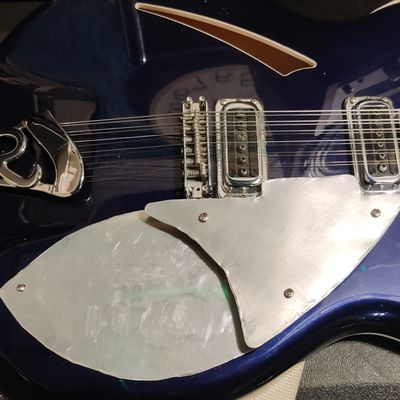
New pickguard traced onto an aluminum cookie sheet. It was tempting to leave it like this. 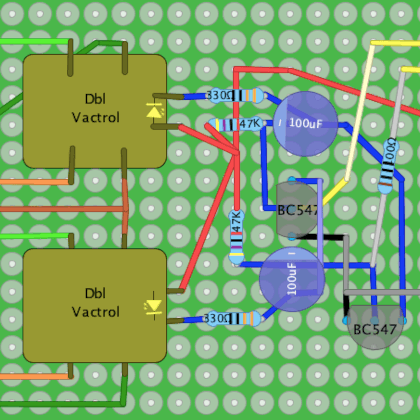
Tremolo layout made with DIYLC 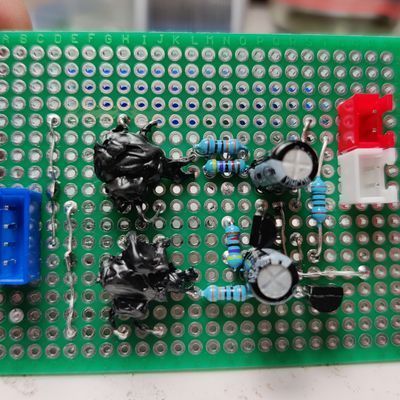
Custom tremolo circuit with DIY double vactrols 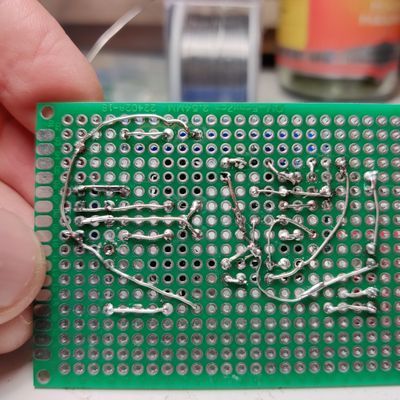
Custom tremolo circuit (reverse side) 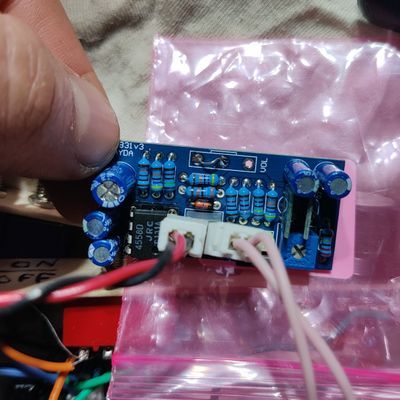
Dan Armstrong Orange Squeezer circuit from Tayda 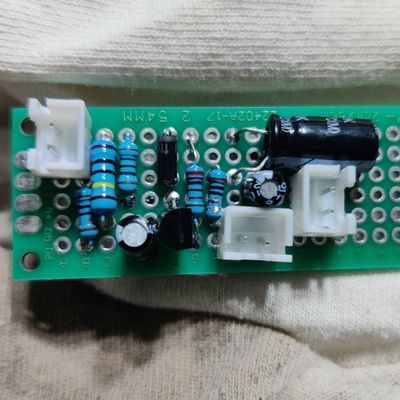
"Alembic Strat-o-blaster" is a lot of fun to say 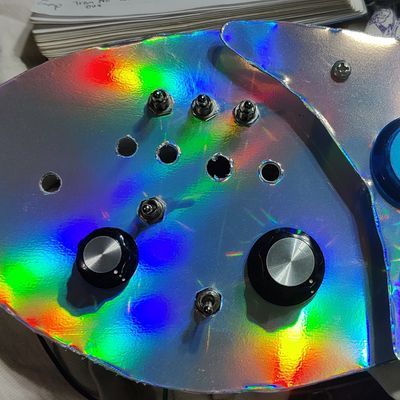
The new pickguard in progress 
Design sketch with colored pencils so I don't get lost doing the wiring. Note the date in the corner—one year ago. 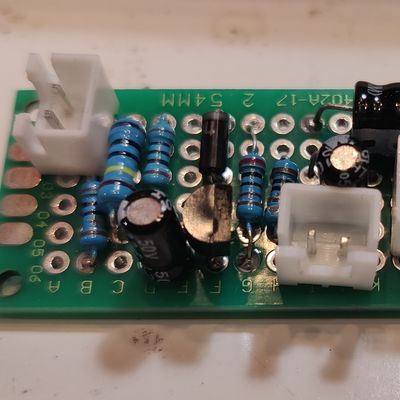
Vox Treble Booster circuit alongside the Alembic Strat-o-blaster 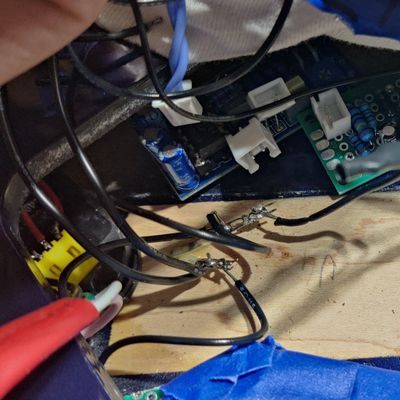
Starting to work out how to place the circuits inside. The cavity seemed a lot bigger before I decided to jam all this junk in there. 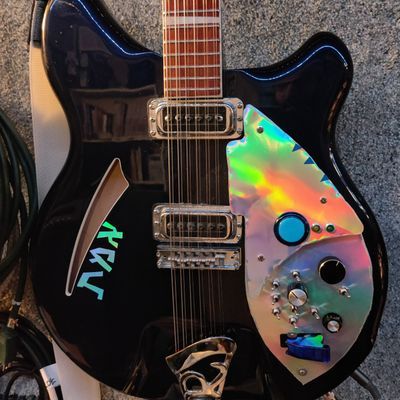
An earlier version without the colorful toggle tips and with a guarded feedback switch (that never quite did what I wanted) 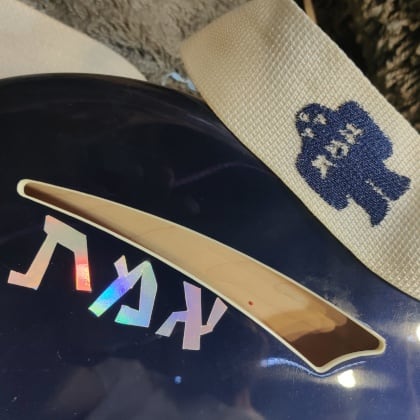
The holy name that brings a golem to life in rainbow holographic vinyl, and a little golem guy embroidered on the strap. 
See you in hell, old pickguard! 
Trying to be thoughtful about where the controls should go and where they can fit. Notice the cool toggle cover on the left. 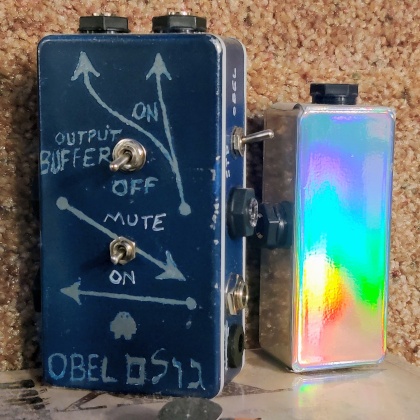
First two iterations of the pedal that goes on the other end of the cables. 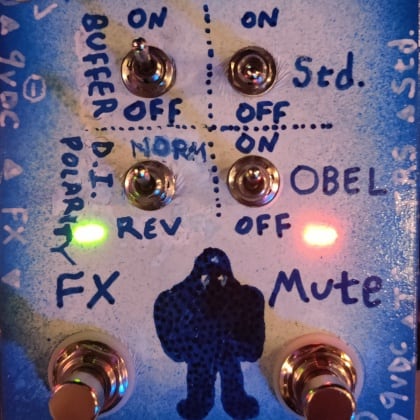
Third iteration of the central control pedal for the OBEL. I'll dedicate a separate post to this guy and its evolution.
- The fifth knob is often erroneously described as a "blend" knob to blend both pickups. It's actually a second volume knob for the neck pickup. The neck pickup will naturally have more output because it's closer to the strings' maximum movement. If you want a more balanced sound between the two pickups you can use that knob to set it how you like it and leave it that way. The rest of the controls will behave nicely now that your pickups have similar output. ⇧Go Back
- Ric-O-Sound comes standard on most Rics. There is a mono jack for the normal output. And next to it is a second jack which is stereo. When a stereo cable is plugged into the stereo jack, the two pickups are separated on the two stereo channels. I don't see it widely used, but I think it's more popular with Rickenbacker basses. ⇧Go Back